Keywords
|
| Building Information Modeling, BIM, data import, IFC (Industry Foundation Classes) format, parsing. |
INTRODUCTION
|
| Recent events, related first of all to the large natural and technogenic catastrophes, show, how useful it would be to have at a critical juncture maximally full computer model that contains information about constructional project. |
| The peculiarity of the information modeling is that all its integrants can be executed in different BIM- programs, the data exchange between integrants is implemented using IFC format [5]. |
| The IFC format is supported by plenty of software developers, in particular Graphisoft, Autodesk, Nemetschek, Robobat, Tekla, Bentley and SCIA [3]. |
| All types of information, that is contained in the Building Information Modeling (BIM), by means of IFC format data communication, can be used in specialized programs, task-oriented management, improvement and maintenance of buildings. |
| The specialized programs of that kind have their subsystems of importing data of IFC file. However, their architecture is closed. |
| The aim of this work is to develop the data import method from the Building Information Modeling (BIM) in specialized programs, task-oriented management, improvement and maintenance of buildings. |
II. DATA MODELS IN BIM
|
| The fundamental difference of IFC format from other formats of data exchange (for example, DWG/DXF) is that it envisages not only complete geometrical description of object in 2D ? 3D but also keeps its interconnections with other objects. Moreover, IFC format contains all functional parameters, carefully elaborated for every type of objects (for example, weight, description of materials, temperature descriptions, price et cetera). |
| BIM is based on the object-oriented parametric models. The specialized model of data presentation about an object that describes the design of certain section is used at different stages of structural engineering. According to the principle of completeness and taking into account setting, the model of building of M should be considered as data integration models that are used at different stages of structural engineering: |
 |
| The model M components are listed below. |
| MA is an architectural building model. Contains information about space and planning arrangement (amount of floors, construction division, elevator mines, stair and so on); |
| MC is a structural – calculation model. It partly includes information about architectural details of the project, and durability of building components; |
| ME is a model of data presentation about electrical engineering intranets and building devices. It includes information about all electrical engineering devices that are used in building, their connections and calculation data; |
| MS is a model of data presentation about sanitary engineering and building devices. It includes information about all sanitary engineering and gas pipeline devices that are used in building, their connections and calculation data; |
| MF is a financial building model. It includes information about the construction cost of the detached element, group of elements, entire floor structure integrally; |
| MM is a model of data presentation about the construction project management. It includes information about the building at break and jaw lines, as well as information about the scheduling of construction activities [4]. |
| Building information modeling (BIM) is a process of developing the only building model that consists of different design parts, and contains all relevant information. Such model can be used for managing building and infrastructure projects at the whole lifecycle stages (construction, rigging, exploitation, repair, dismantling). |
| The building information model carries the following information: |
| 1. Object configurations (sizes, volume et cetera); |
| 2. Physical parameters of objects(mass, material, physical constants et cetera); |
| 3. Attributive parameters of objects (name, types of sections, marking, GOST, State All-Union standard et cetera). |
| 4. Topological parameters; |
| 5. Time parameters of objects. |
III. PARSING OF IFC FILE
|
| The hierarchical arrangement is the basis for the IFC model. Applicability of object-oriented approach allows complex liaising between objects. Among physical objects, we distinguished doors, windows, walls and more conceptual objects. |
| Parsing the file requires development of parsing system to import BIM parameters from an IFC file. |
| The IFC hierarchy covers the core project information such as building elements, the geometric and material properties of building products, and so on. The most abstract entity in the IFC model is IfcRoot, which is the kernel and provides attributes for the identification, ownership, and self-description of all sub-entities. (fig.1.). |
| Thus, IfcRoot is the parent for three subtypes, IfcObjectDef (generalizing any object or process), IFcPropertyDef (defining characteristics to entities), and IfcRelationship (describing relationship between entities). All the elements are identified from the super-class IfcObjectDef. The building elements category has fifteen groups of elements (e.g. walls, doors, stairs, beams, columns, et cetera.). Each element inherits attributes from all of its parent entities, such as geometric representation information (IfcObjectPlacement and IfcRepresentation). IfcObjectPlacement stores the placement information of an object. It contains the coordinates (x,y,z) which could be absolute (relative to the global coordinate system), relative (relative to the IfcObjectPlacement of another object), or constrained (relative to the grid axes). IfcRepresentation stores the shape representations of an object. |
| There are two geometric shape representations: |
| 1) the explicit geometric representation of the shape (i.e. points, curves, surfaces, and solid boundaries; for example, a wall could be defined with 8 points, 12 edges and 6 surfaces.); and |
| 2) the attribute-driven representation of the shape (i.e. extruded profiles, directions, length, and width).Every element such as a wall could have length, width and height[5]. |
| Each specific element could have particular attributes inherited from IfcObjectPlacement and IfcRepresentation, IfcWall presented in Fig. 2. |
| Inherited from IfcWall, IfcWallStandardCase contains the standard information of each wall. IfcWallStandardCase contains IfcLocalPlacement and IfcProductDefinationShape (the subclass of IfcRepresentation). |
| IfcLocalPlacement could not only have the attribute of IfcAxis2Placement3D with IfcCartesianPoint (coordinates) and IfcDirection (the trend of spreading) that are relative to the global coordinate system, but also could have the reference of another IfcLocalPlacement with relative coordinates. IfcProductDefinationShape contains IfcRectangleProfileRef with length, width and height and IfcPolyline with boundary points. In other words, IfcLocalPlacement represents the starting point, while IfcProductDefinationShape indicates where we can place it (in which way and how far). |
| Object-oriented model class subsystem of importing data from IFC to specialized programs presented in Fig.3. |
| Any external application can transfer the importing data from IFC file directly to the DB elements, using parsing subsystem and after all element parsed we get exact descriptions of building elements required directly for the solution to the tasks by means of this program(Fig.4). |
| Any external BIM application is able to develop IFC document. Currently it is supported by most of the major Computer-aided design (CAD) system vendors as well as by various analysis applications. The importing program converts it into DB database of user CAD system. The architecture of parse system, as subsystems of user CAD system is presented in Fig.5. |
| One of actual directions of usage of such parsing subsystem is the specialized design facilities of energy efficient buildings. BIM data are reliable and dynamically renewed. Usage of these data and methods of designing of energyefficient buildings allows at the very stage of planning to expect the heating engineering indexes of non-load-bearing constructions, design the process of environment influences et cetera. |
IV. CONCLUSION
|
| The fundamentally new approach in the architectonically building design has appeared regarding the recent development of information technologies. It is based on the creation of the computer model of building and contains all information about a future or realized project. Cognition about specification of building from a BIM now kept in the informative model of building. |
| All types of information that is contained in building information model, by means of IFC format for importing data can be used in specialized programs, task-oriented management, improvement and maintenance of buildings |
| In this paper, we developed the functioning model of IFC file parsing subsystem. Any external application can transfer the importing data from IFC file directly to the DB elements, using parsing subsystem and after all element parsed we get exact descriptions of building elements required directly for the decision of tasks by means of this program. |
| All information about the object construction stored in the building information model (BIM) is reliable and dynamic, therefore appropriate use of specialized software products aimed at the control problem, improvement and operation of buildings. |
ACKNOWLEDGEMENTS
|
| The author would like to thank A.O. Biloshchyts'kyy for fruitful discussions about subsystems of CAD energy efficient buildings. |
Figures at a glance
|
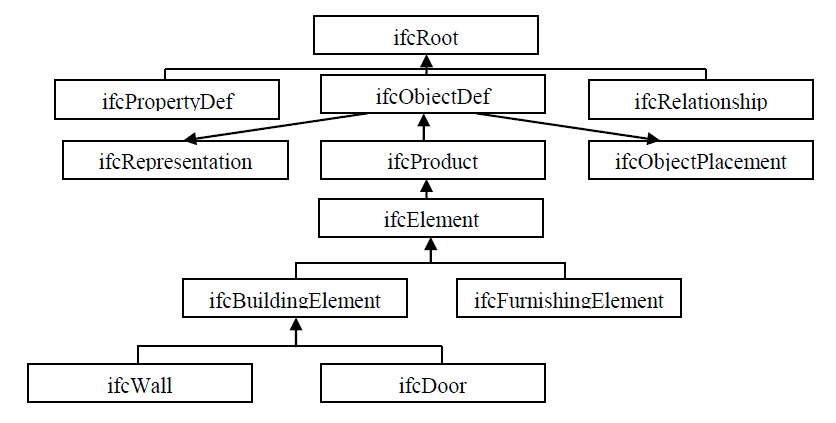 |
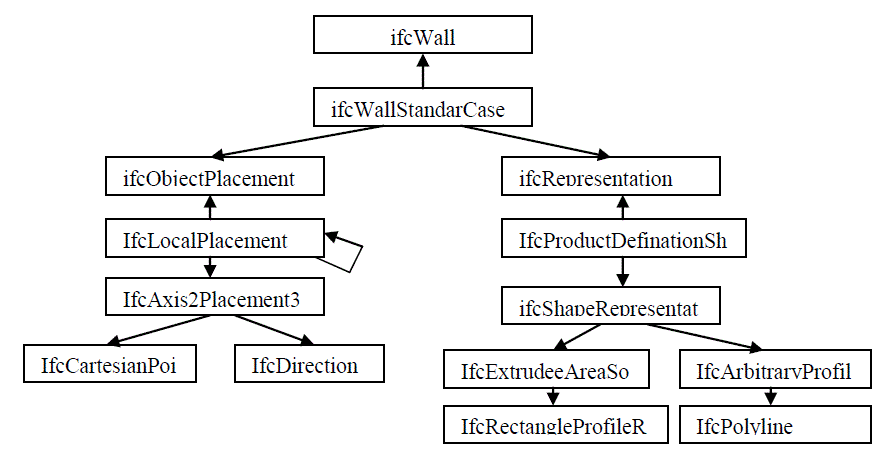 |
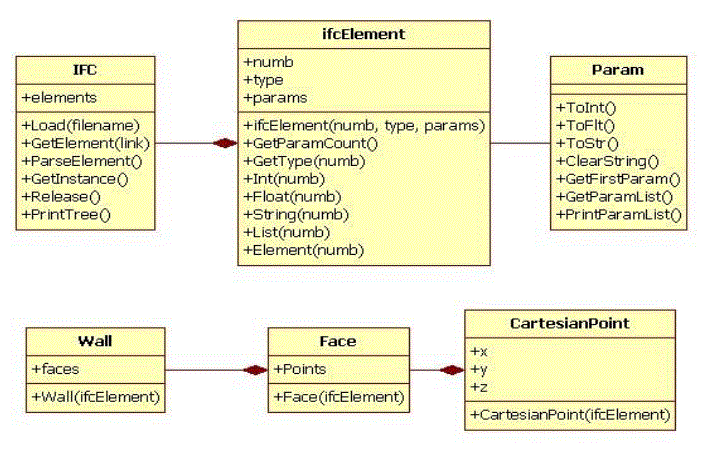 |
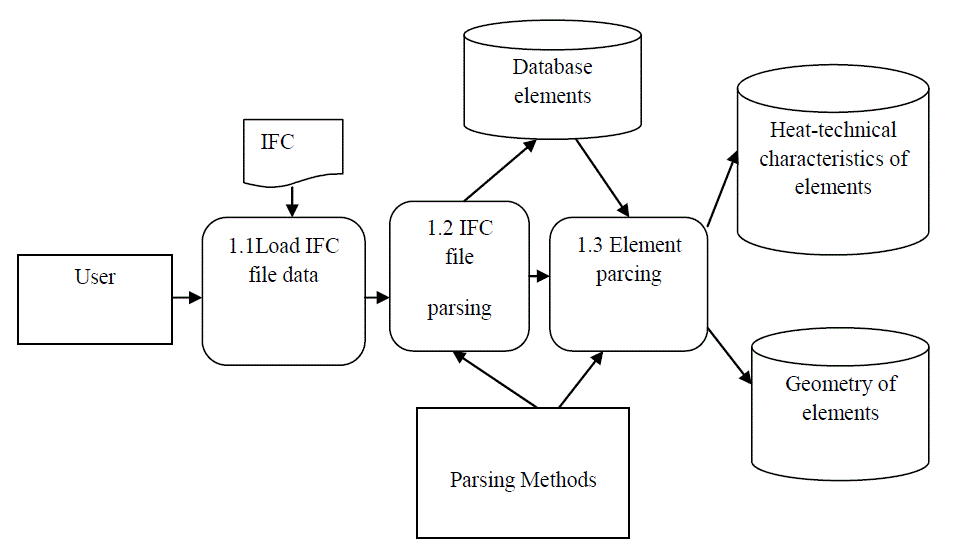 |
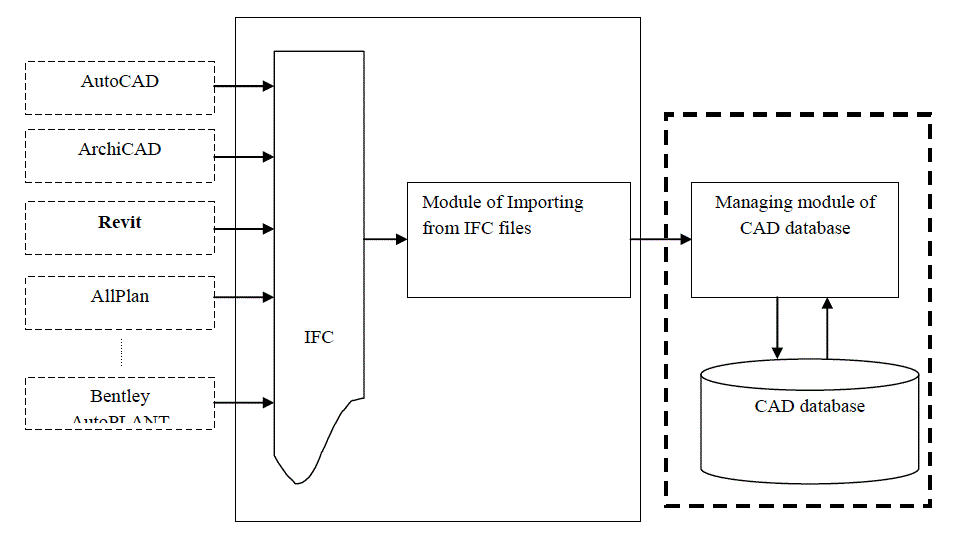 |
| Figure 1 |
Figure 2 |
Figure 3 |
Figure 4 |
Figure 5 |
|
| |
References
|
- Talapov V.V.. Basics of BIM. Introduction to building information modeling. Moscow: DMK press ", p. 392, 2011.
- Jones J. K. Design methods, Moscow, Mir, 326 p, 1986.
- Gots Kh.?. “Using modern technology CAD design for energy efficient buildings”, Management of Development of Complex Systems, Collected Scientific Papers, Kyiv, KNUCA, Vol. 11, no. 11, pp. 100-106, 2012.
- Borodavka Ie.V. “The representation methods of building object”, Management of Development of Complex Systems, Collected Scientific Papers, ?yiv, KNUCA, Vol. 8, no. 11, pp. 100-106, 2011.
- Sixuan Wang, Gabriel Wainer, Rhys Goldstein, Azam Khan “Solutions for scalability in building information modeling and simulation-based design”, Society for Computer Simulation International San Diego, CA, USA , 2013
- Autodesk Exchange/Available at: http://exchange.autodesk.com (accessed 7 December 2013)
|